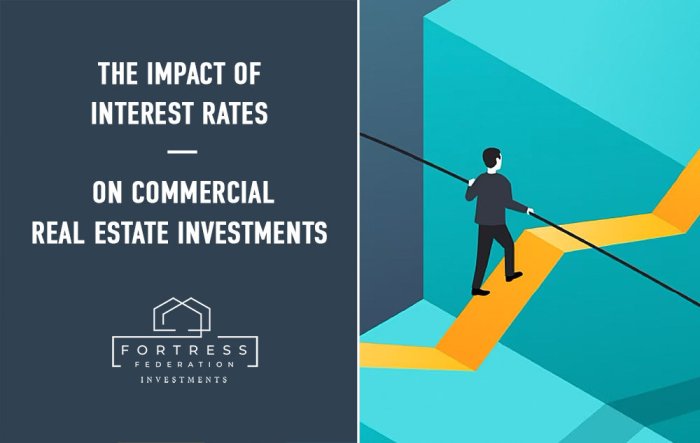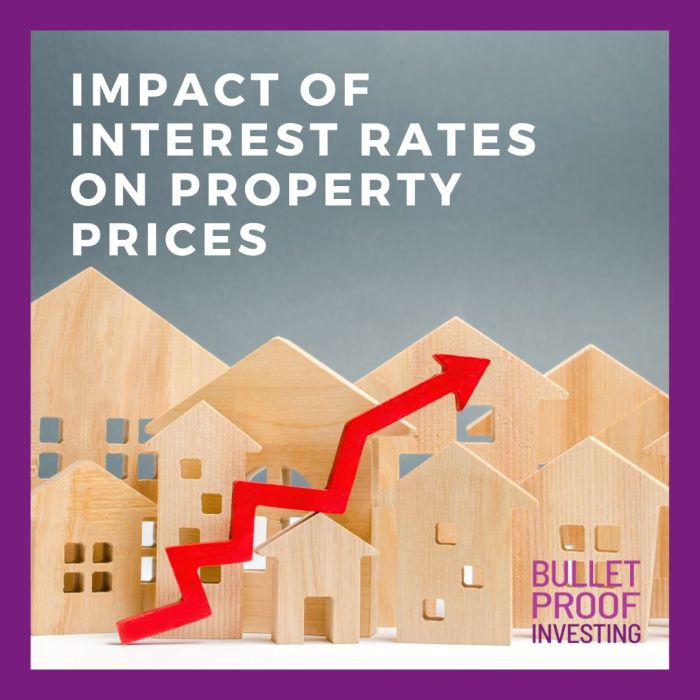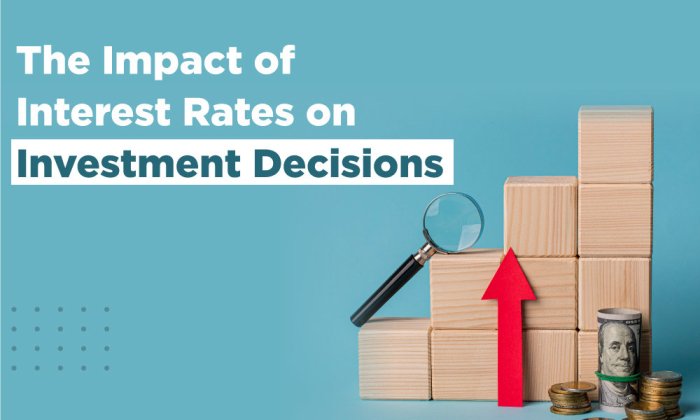How Interest Rates Impact Property Investment Returns
How Interest Rates Impact Property Investment Returns is a crucial topic for anyone looking to navigate the real estate market effectively. Understanding the dynamics of interest rates can significantly influence your investment decisions, whether you’re a seasoned investor or just starting out. This exploration will lead you through the intricate relationship between interest rates and property investment, revealing how fluctuations can impact your potential returns.
As we delve into historical trends, the effects of interest rates on borrowing costs, property prices, rental yields, and cash flow, you’ll gain insights that are essential for making informed investment choices. With a focus on both short-term and long-term impacts, this discussion aims to equip you with the knowledge needed to adapt your strategies based on current economic conditions.
Introduction to Interest Rates

Source: wixstatic.com
Interest rates are the cost of borrowing money or the return on invested funds, expressed as a percentage. They play a crucial role in the economy by influencing consumer behavior, business investments, and overall economic growth. Central banks, like the Federal Reserve in the United States, determine interest rates through monetary policy decisions, affecting the supply of money and credit in the economy.
Factors such as inflation, employment rates, and geopolitical events also impact these rates, making them dynamic and subject to change.Historically, interest rates have fluctuated significantly over the past few decades. For instance, in the early 1980s, rates soared to as high as 20% in the U.S. due to inflation control measures. By the mid-2000s, rates were around 5-6%, only to plummet to near zero during the financial crisis of 2008.
This downward trend continued into the 2020s as central banks sought to stimulate economies grappling with the effects of the COVID-19 pandemic.
Impact of Interest Rates on Different Economic Sectors
Interest rates have far-reaching effects across various economic sectors. Understanding these effects can provide insights into investment strategies and economic health. Some key sectors impacted by interest rates include:
- Real Estate: Lower interest rates reduce mortgage costs, making it easier for individuals to buy homes. This can lead to increased property demand and higher prices. Conversely, rising rates may cool down the housing market, leading to decreased sales and potential price corrections. For instance, when rates increased in 2018, many markets experienced slower home sales and price stagnation.
- Consumer Goods: Higher interest rates typically lead to increased borrowing costs for consumers, which can dampen spending on non-essential goods. Retailers often see a decline in sales during periods of high rates, as consumers prioritize essential expenses over luxury items.
- Automotive: The auto industry is sensitive to interest rates, as most vehicle purchases are financed through loans. Lower rates can boost car sales, while higher rates tend to discourage purchases, leading to decreased sales and potentially lower production rates.
- Investment Sector: Interest rates influence the costs of capital for businesses. When rates are low, companies can borrow more cheaply to invest in expansion and growth. Conversely, high rates can restrict access to financing, thereby stifling growth and innovation.
Understanding the relationship between interest rates and these sectors provides valuable insights for investors and policymakers in navigating economic cycles.
Relationship Between Interest Rates and Property Investment
As property investors navigate the complexities of the real estate market, understanding the relationship between interest rates and investment returns is crucial. Interest rates serve as a fundamental driver of economic activity, influencing borrowing costs, property prices, and overall investment viability. Rising interest rates have a direct impact on the cost of borrowing, which is a critical factor for property investors.
When interest rates increase, the monthly mortgage payments on loans also rise, leading to higher overall borrowing costs. This situation can strain cash flow for investors who rely on financing to purchase properties. Higher borrowing costs may necessitate larger down payments or prompt investors to seek less expensive properties. For example, if the interest rate rises from 3% to 5%, a loan of $300,000 would increase the monthly payment by approximately $300, significantly impacting an investor’s budget.
Impact on Property Prices
Interest rate fluctuations influence property prices significantly, and understanding this dynamic is key for investors. When interest rates rise, potential homebuyers may be discouraged from entering the market due to higher borrowing costs, leading to reduced demand. This reduction can result in a cooling effect on property prices. Conversely, when interest rates are low, borrowing becomes more attractive, stimulating demand and driving property prices upward.
The correlation between interest rates and property prices can be illustrated with the following points:
- Higher interest rates increase borrowing costs, reducing affordability for buyers and potentially leading to lower property prices.
- Lower interest rates enhance affordability, encouraging more buyers to enter the market, which can drive property prices up.
- Trends in interest rates can lead to market cycles; for instance, prolonged low rates can create housing bubbles, while rapid increases can lead to market corrections.
Effects on Rental Yields and Cash Flow
Interest rate changes also play a critical role in determining rental yields and overall cash flow for property investors. With rising interest rates, the increased cost of financing can diminish the net rental income, as more of the rent goes towards covering mortgage payments. Consequently, investors may find their cash flow becoming strained, which can affect their ability to maintain or invest further in their properties.Several key effects illustrate this relationship:
- As interest rates rise, landlords may need to adjust rental prices to maintain positive cash flow, which could impact tenant demand.
- In a rising rate environment, properties with existing low-rate mortgages may become more desirable, as they provide better cash flow compared to properties requiring new financing.
- Conversely, lower interest rates can enhance rental yields, making properties more attractive to prospective investors as cash flows improve.
In summary, the interplay between interest rates and property investment returns shapes the landscape for property investors. Understanding these dynamics can better equip investors to make informed decisions in a fluctuating economic environment.
Short-term vs Long-term Impacts

Source: com.au
The fluctuation of interest rates can significantly influence property investment returns, manifesting in both short-term and long-term implications. Understanding these impacts is essential for investors to tailor their strategies effectively, ensuring optimal returns on their investments regardless of current market conditions.Immediate changes in interest rates directly affect borrowing costs, which can lead to swift alterations in purchasing power and investment decisions.
For instance, when interest rates rise, the cost of financing a property increases, potentially leading to decreased demand in the market. This can result in lower property prices and weaker rental yields as buyers and investors reassess their budgets and financial capabilities.
Immediate Effects of Interest Rate Changes on Property Investments
The immediate effect of interest rate changes can swiftly alter the landscape for property investors. Key points to consider include:
- Increased Borrowing Costs: Higher interest rates directly increase mortgage repayments, reducing cash flow and potentially affecting investment decisions.
- Market Demand: As financing becomes more expensive, potential buyers may retreat from the market, leading to a slowdown in property transactions.
- Rental Yield Pressure: Higher costs may force landlords to increase rents, but market conditions may limit their ability to do so, affecting overall yield.
- Investment Sentiment: Positive or negative market sentiment can shift rapidly in response to interest rate changes, influencing short-term investment strategies.
Long-term Consequences of Sustained High or Low Interest Rates
The long-term implications of interest rate environments can shape the investment landscape over years. Sustained periods of high or low rates create distinct scenarios that investors should be aware of:
| Interest Rate Environment | Long-term Impacts |
|---|---|
| High Interest Rates |
Lower demand can create a buyer’s market, leading to potential bargains, but also increased risks for property owners facing higher mortgage debts. |
| Low Interest Rates |
While this can lead to increased property values, investors must contend with the possibility of a market correction when rates eventually rise. |
Understanding both the short-term and long-term impacts of interest rate changes is crucial for investors to navigate the property market effectively. By adapting strategies based on current economic conditions, property investors can optimize their returns while mitigating risks associated with interest rate fluctuations.
Investment Strategies in Varying Interest Rate Environments
In the world of property investment, understanding how interest rates influence investment strategies is crucial for maximizing returns. Different interest rate environments can lead to unique challenges and opportunities for investors. Adapting strategies according to these fluctuations not only helps mitigate risks but can also enhance the potential for profit.
Investment Strategies for High Interest Rate Environments
When interest rates are high, property investors face increased borrowing costs, which can squeeze profit margins. Therefore, adopting specific investment strategies can help capitalize on the situation while minimizing risks. Here are some strategies to consider:
- Focus on cash flow properties: Prioritizing properties that generate consistent cash flow can help mitigate the impact of high financing costs. For example, investing in multi-family units or rental properties in areas with strong demand can provide a stable income stream.
- Consider shorter loan terms: Opting for shorter mortgage terms can help investors avoid long-term exposure to high interest rates, allowing for refinancing opportunities when rates potentially drop.
- Explore fixed-rate mortgages: Locking in fixed rates can protect against future rate increases, ensuring predictable monthly payments regardless of market fluctuations.
- Invest in value-add properties: Targeting properties that need renovations or upgrades can increase value over time, making them more appealing even if borrowing costs are high. For instance, purchasing a distressed property, renovating it, and then either renting or selling at a profit can yield substantial returns.
Investment Strategies for Low Interest Rate Environments
Conversely, low interest rate environments present opportunities for leveraging debt to maximize returns. Investors can take advantage of lower borrowing costs to expand their portfolios and enhance property values. Here are key strategies to implement in such conditions:
- Utilize leverage effectively: Low rates make it more affordable to borrow, allowing investors to acquire additional properties without significantly increasing debt burdens. An investor could purchase multiple rental properties using the same cash flow generated from existing assets.
- Refinance existing loans: Refinancing older, higher-interest loans can free up cash flow for reinvestment or improvement projects. This is particularly beneficial for investors holding properties with significant equity.
- Invest in growth areas: Low interest rates can stimulate economic growth, making it an ideal time to invest in emerging neighborhoods or regions showing signs of development. For example, an investor could focus on suburban areas experiencing population influx due to remote work trends.
- Consider commercial properties: Lower rates can make financing commercial real estate more attractive. Investing in office spaces or retail properties may yield higher returns, particularly if they are located in areas with strong economic activity.
Hedging Against Interest Rate Risks
Investors can implement various approaches to hedge against the risks associated with fluctuating interest rates. These strategies help safeguard investment returns and provide a measure of financial security. Key methods include:
- Diversifying the portfolio: Having a mix of property types—residential, commercial, and industrial—can reduce overall risk. For example, if residential properties are underperforming due to high interest rates, commercial properties may still bring in steady income.
- Using options and derivatives: Engaging in financial instruments such as interest rate swaps can help manage exposure to rising rates. Investors can lock in favorable rates or offset potential losses through these contracts.
- Maintaining liquidity: Keeping a portion of the investment portfolio in liquid assets allows for quick responses to changing rate environments. This flexibility ensures that cash is available for new opportunities or to cover expenses during downturns.
- Establishing a contingency fund: Setting aside an emergency fund can provide a safety net during periods of high borrowing costs, allowing investors to manage their properties or cover unexpected expenses without impinging on cash flow.
Economic Indicators Related to Interest Rates
Economic indicators serve as vital tools in understanding how interest rates influence property investment. These indicators not only reflect the current economic conditions but also help investors predict future trends in the property market. Among the key indicators are inflation rates and unemployment rates, both of which significantly impact property investment returns.The relationship between interest rates and inflation is a critical aspect of the economic landscape.
When interest rates rise, borrowing becomes more expensive, which can slow down economic growth and ultimately affect property markets. Conversely, lower interest rates can stimulate inflation, leading to increased property values. Understanding this correlation is essential for investors to navigate market stability and make informed decisions.
Inflation Rates and Property Market Stability
Inflation rates directly correlate with interest rates, creating a ripple effect on the property market. When inflation rises, central banks typically increase interest rates to control spending and stabilize the economy. This reaction can lead to several significant outcomes for property investors:
- Higher borrowing costs: Increased interest rates mean that loans become more expensive for potential homebuyers, which can decrease demand for properties and lead to slower price growth.
- Decreased purchasing power: As inflation erodes the value of money, consumers may find it harder to afford homes, potentially leading to a slowdown in the property market.
- Investment in real estate as a hedge: Investors often turn to real estate as a means of protecting their wealth against inflation, which can provide some support to property prices even in challenging economic times.
Unemployment Rates and Property Investments
Unemployment rates play a crucial role in shaping the property investment landscape, especially in relation to changing interest rates. As interest rates fluctuate, the labor market can experience varying levels of stability. This connection highlights essential factors for investors to consider:
- Impact on demand: High unemployment rates often result in decreased consumer confidence, reducing the number of potential buyers in the housing market and leading to slower property sales.
- Rental market implications: In times of high unemployment, more individuals may choose to rent rather than buy, which can increase demand in the rental market but also pressure rental rates.
- Potential for investment opportunities: During periods of high unemployment, property prices may stagnate or decrease, presenting opportunities for savvy investors to acquire properties at lower prices.
“Interest rates are not just numbers; they are the pulse of the economy, directly influencing inflation and employment, which in turn shape the property investment landscape.”
Case Studies of Interest Rate Changes
Interest rates play a crucial role in shaping property investment landscapes. Historical case studies provide valuable insights into how fluctuations in interest rates can significantly influence property markets, both positively and negatively. Understanding these examples helps investors strategize better in varying economic climates.Analyzing past interest rate changes reveals patterns that can guide current and future investment decisions. The following case studies highlight notable instances where shifts in interest rates had marked effects on property values and investment outcomes, demonstrating the direct correlation between monetary policy and real estate performance.
Notable Case Studies of Interest Rate Changes
The historical context of interest rates and their impact on the property market is essential for understanding today’s investment climate. Below is a table summarizing key cases where interest rate changes influenced property investment outcomes:
| Year | Interest Rate Change | Impact on Property Market | Example of Success/Failure |
|---|---|---|---|
| 2008 | Federal Reserve lowered rates to near 0% | Stimulated housing market recovery | Increased property values post-recession, successful investments in foreclosures. |
| 2015 | Interest rates increased from 0.25% to 0.50% | Gradual cooling of the housing market | Some investors faced losses as property appreciation slowed. |
| 2020 | Rates cut to 0-0.25% due to COVID-19 | Surge in demand for suburban properties | Successful investments in suburban areas as urban flight increased. |
| 2022 | Federal Reserve raised rates to combat inflation | Decline in property sales and values | Investors holding properties faced decreased equity and increased holding costs. |
These case studies illustrate how interest rate changes can lead to varied outcomes in property investments. For instance, the drastic rate cuts during the 2008 financial crisis led to a significant rebound in property values as buyers flocked to the market seeking affordable mortgages. Conversely, the rate hikes in 2022 resulted in a cooling effect, as potential buyers were deterred by higher borrowing costs, leading to a decline in property sales and market values.
“Interest rates are a crucial signal for property investors, affecting both supply and demand in the real estate market.”
Investors must keep an eye on these historical trends to navigate the real estate market effectively. By analyzing past performance and recognizing the patterns that emerge from interest rate changes, investors can better position themselves for success in various economic scenarios.
Global Perspectives on Interest Rates and Property Investment
The relationship between interest rates and property investment is not a localized phenomenon; it spans across borders and significantly influences global markets. Understanding how interest rate trends vary in different countries can provide valuable insights into potential property investment returns. This section delves into the global landscape of interest rates and their implications for property investors.Economic conditions worldwide shift the interest rate landscape, often affecting real estate markets in unexpected ways.
Countries with rising interest rates may see a cooling in property market activity, while those with lower rates could experience increased demand. This dynamic creates a complex interplay where investors must remain vigilant and adaptable to global economic shifts.
Comparison of Interest Rate Trends
Analyzing interest rate trends across various countries highlights contrasting economic strategies and their effects on property investment returns. For instance, the United States and Canada have experienced gradual rate increases, aimed at curbing inflation, which has led to a tempering of property price growth. In contrast, nations like Japan have maintained ultra-low rates for years, fostering a unique environment for property investments despite stagnant economic growth.Key observations include:
- United States: The Federal Reserve’s hikes in interest rates have tightened mortgage availability, causing homebuyers to reassess their budgets and influencing property values.
- Australia: With a similar trajectory of rate increases, property investors are strategically shifting focus to higher-yielding areas, seeking stable returns amid rising costs.
- Germany: Low interest rates have driven foreign investment into the property sector, contributing to rapidly increasing prices in major cities.
- Brazil: Recent reductions in interest rates have spurred a resurgence in property investments, attracting both local and international investors seeking opportunities in a recovering market.
Influence of Global Economic Shifts
Global economic shifts, such as trade agreements, political stability, or crises, directly impact local interest rates and investor behavior. For instance, the onset of the COVID-19 pandemic prompted central banks worldwide to lower rates to stimulate economic recovery. This led to an influx of capital into property markets, as investors sought refuge in tangible assets amid market uncertainties.The interconnectedness of economies means that changes in one region can ripple through to affect interest rates elsewhere.
For example, the economic recovery in China has implications for global commodity prices, which can subsequently influence interest rates in resource-dependent countries.
International Investment Strategies in Response to Varying Global Interest Rates
Investors often adapt their strategies based on global interest rate environments to optimize returns. In a low-interest-rate setting, investors tend to pursue aggressive acquisition strategies, leveraging borrowed capital to maximize their portfolios. Conversely, in high-interest-rate periods, the focus may shift toward consolidating assets, reducing debt, or seeking more stable, cash-flow generating properties.Emerging strategies include:
- Diversification: Investors are increasingly diversifying their portfolios across markets to mitigate risks associated with rising interest rates in their home countries.
- REITs (Real Estate Investment Trusts): Many are turning to REITs as a way to gain exposure to real estate without the direct impact of fluctuating mortgage rates.
- Location Analysis: Evaluating properties in regions with favorable interest rates while considering local economic indicators helps investors make informed decisions.
Wrap-Up

Source: wixstatic.com
In summary, navigating the realms of property investment requires a keen understanding of how interest rates shape the landscape. As we’ve seen, the effects of rising or falling rates can profoundly influence your investment outcomes, from immediate cash flow implications to long-term appreciation potential. By staying informed and strategically adjusting your approach to accommodate these economic shifts, you can enhance your investment success and build a resilient portfolio.
Questions Often Asked
How do interest rates affect mortgage payments?
Higher interest rates lead to increased mortgage payments, making borrowing more expensive, while lower rates reduce monthly payments.
What is the impact of interest rates on property values?
Rising interest rates typically lead to decreased property values as higher borrowing costs deter buyers, while lower rates can stimulate demand and increase values.
How can investors hedge against interest rate risks?
Investors can hedge against interest rate risks through fixed-rate mortgages, diversifying their portfolio, or investing in real estate investment trusts (REITs) that perform well in varying rate environments.
What role does inflation play in relation to interest rates?
Inflation often leads to higher interest rates as central banks increase rates to control rising prices, which in turn affects property investment returns.
Are there specific property types that perform better during high interest rates?
Generally, properties with stable cash flows, like multi-family rentals, tend to perform better during high interest rate periods compared to speculative investments.
How often do interest rates change?
Interest rates can change multiple times a year depending on economic conditions, central bank policies, and other financial indicators.









